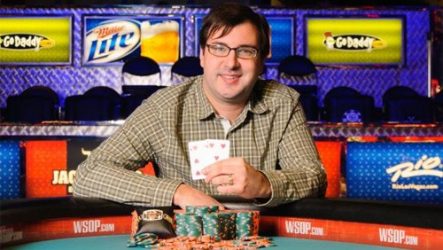Last week, we spoke with Matt Matros about his 2004 poker book The Making of a Poker Player. This week, we caught up with the three-time WSOP bracelet winner to discuss his hotly anticipated follow-up The Game Plan, which was published last year, a full 15 years after its predecessor. So what took Matros so long to return to the keyboard?

[Image credit: WSOP.com]
“I’d had to cut back on my playing schedule considerably as I became a father two and a half years ago,” he tells us, “My wife works full time, so I’ve spent a lot of my time being a parent and that makes travelling to poker tournaments a lot more difficult. Live poker – and multi-table tournaments were my main game. I had to figure out what I wanted my poker life to be again. I figured writing about the game might be a way back in.”
When it comes to the MTTs that Matros plays, he often meets players who need improvement but aren’t full professionals, and he saw a gap in the publishing market.
“A lot of players are very passionate about poker but are stuck at a certain level. There really wasn’t a book designed to help them get better results. There are books designed to help players accrue knowledge and become professional and there are books aimed at perfecting professionals’ skills. There weren’t too many that could explain quick things that improve a casual player’s results almost immediately. That was the book I wanted to write.”
Taking to the typewriter, Matros produced The Game Plan. He decided to self-publish rather than go back down the traditional route like he did the first time he was published.
“The self-publishing world in this day and age allows for writers to take a much greater percentage of the profits than traditional publishers,” says Matros, “If you have a built-in audience, and poker players or authors sometimes do you can make more. Of the two books, The Making of a Poker Player was written in the poker boom and the other published last year. In terms of sheer numbers, I’ve sold way less of The Game Plan but I’d say I’ve made the same from each book. My friend Ed Miller had success with that model, and he steered me in that direction. I needed to get back into poker because I was missing it – this allowed me to do that.”
The hands that Matros analyses in The Game Plan come from the World Series of Poker Main Event and the unique nature of the event, like so many of the players Matros has outlasted over the years, played right into his hands.
“My first conception of the book was specifically to help players play the WSOP Main Event. It still very much does that for an amateur player, but I don’t limit it to the Main Event. It’s helping a casual player succeed in a fast way. If their plan is to play the Main Event in a few weeks, they can read this book to give themselves a better shot. It’s a crazy tournament. You won’t see such a disparity of skill levels in any other event. Almost all the best players in the world are playing the Main Event and an enormous number of rank beginners who barely know the rules are in there too, as well as everyone in between.”
The sheer variety involved in the Main Event meant Matros could set out rules that would help players to follow.
“The Game Plan lays out rules for players to follow that will give them a shot and take the thinking out of the game for them. By using the WSOP Main Event, there were a lot of different scenarios to explore. I also wanted to give more serious players a reason to pick the book up. While they’re prob not going to apply the Rules of The Game Plan while they’re competing, they can read some of the hands I’ve played in the Main Event as I’m saying what I’ve done in these hands even if it’s different from what the Game Plan would suggest a player does. There were a lot of benefits to using Main Event hands and people just love to read about hands in that tournament.”
Having won three WSOP bracelets in his career, Matros would love a fourth bracelet. He’s realistic to know, however, that it takes a lot of grinding these days to put yourself in the position to do so.
“Obviously, winning three WSOP bracelets in 2010, 2011 and 2012 are my career highlights to this point, but I play a much more abbreviated schedule now. To make an effort at it, you’ve got to grind a lot of events. For now, it’s hard enough to fit the Main Event in – that’s a long enough event itself. Last summer, I cashed in two events, including one deep run, then I came home because I couldn’t be out there for potentially another fortnight for the Main Event. At this point it’s not a priority.”
Matros puts his personal take on what’s brought him so much success.
“Part of it is my style. I’m often playing for the win. It’s mostly coincidence that the wins have come at the World Series, but I seem to have better luck at the WSOP. You can see patterns in anyone’s tournament history. We might only play hundreds or maximum thousands of tournaments in your life, it’s a very small sample size.”
One of his best wins was in the 6-Max event where he beat some great players to the trophy including Ramey Shaio, Gordon Vayo and Mark Radoja, who he beat heads-up.
“It was so strange. I lost a massive pot with 30 players left with 200+ blinds in the middle which was crazy. I had two kings and was rivered by ace-king. Every time I had to show down a hand from there, I seemed to win. Even at the final table, I won a massive coinflip to move into the chip lead.”
Heads-up, Matros took on the experienced Mark Radoja. It was a seismic battle.
“I got it in with Mark and he had a straight and I had a flush draw. It came in and I won the tournament, when if I’d lost that pot we would have been back to even. There were a lot of cold decks in that tournament and luckily for me the good luck won out. It was a tough field – Gordon I known for a long time and he’s a very nice guy and a strong player. Mark Radoja is just an incredibly successful tournament player. It was a fun final table and high-level competition.”
What’s next for Matros? Well, he hopefully won’t wait a decade and a half before releasing another poker book. In fact, he knows what he’d like to write about next.
“I’m thinking of following up The Game Plan with an idea about how to analyse poker hands. You see a lot of books that do analyse hands, and tell you how you should have played, but you don’t see the meta point which is how you go about breaking down a hand. What questions are you supposed to be asking?
The idea of hand analysis is as old as the hills, but how to do it is not something commonly discussed. Merely looking at a hand is deemed to be productive, when that might not be the case.
“A lot of questions tend to get lumped together in hand analyses. A lot of strong players might read a lot of analysis but don’t know how to create that analysis for themselves. I’m looking at training people to break down hands, because its one of the main ways I’ve improved. If I can help others with that, I’d like to pass that information on. It sounds easy, but so did The Game Plan and it really wasn’t. There were many points during the books where I feared it wouldn’t work, but in the end I’m hopeful that it did.”
As ever, Matt Matros, just like he did when he won his three World Series of Poker, has got the job done. As with The Making of a Poker Player, his new release The Game Plan looks set to inspire another generation of poker players.












